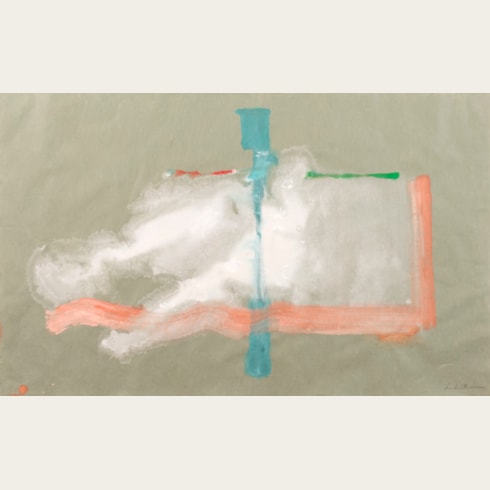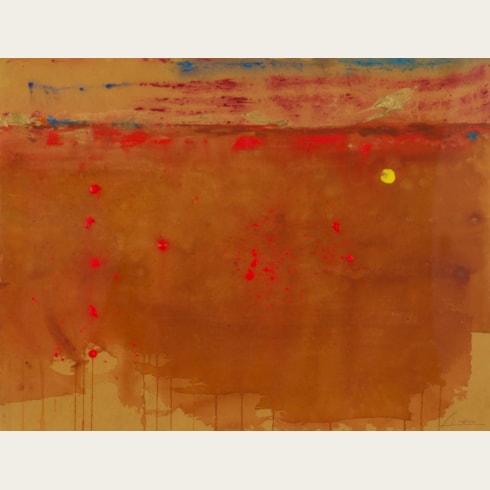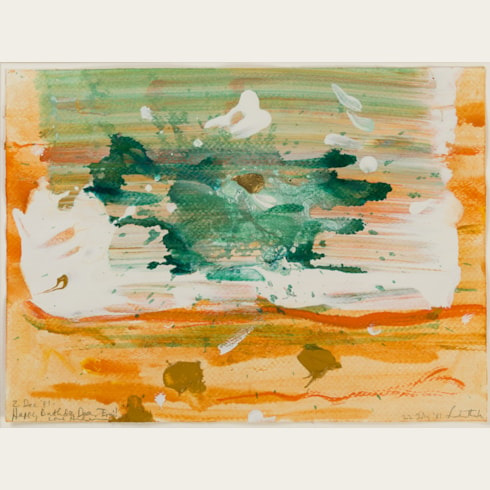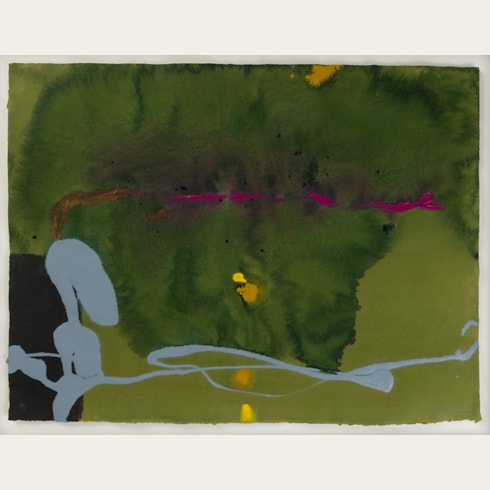Helen FRANKENTHALER
(New York 1928 - Darien 2011)
Untitled (P91-20), 1991
Gouache, watercolour and coloured chalks (with oil?) on handmade paper.
Signed and dated Frankenthaler 91 in pencil at the lower right.
Inscribed Geschenk von Helen Frankenthaler / erhalten am 10.8.1991 / Titel: P91-20 / Gemalt auf Papier No.34.1 aus / Strange Papers on a typewritten label pasted onto the old backing board.
216 x 283 mm. (8 1/2 x 11 1/8 in.)
Signed and dated Frankenthaler 91 in pencil at the lower right.
Inscribed Geschenk von Helen Frankenthaler / erhalten am 10.8.1991 / Titel: P91-20 / Gemalt auf Papier No.34.1 aus / Strange Papers on a typewritten label pasted onto the old backing board.
216 x 283 mm. (8 1/2 x 11 1/8 in.)
The present sheet is drawn on an unusual type of handmade paper supplied to Frankenthaler by the Swiss papermaker Fred Siegenthaler (b.1935), who also is likely to have been the recipient of the drawing as a present from the artist in 1991. Trained first in Switzerland and later in Munich, Siegenthaler worked as a paper engineer for the pharmaceutical company Sandoz AG, conducting research into producing paper products using various raw materials. He travelled extensively, living for long periods in South and North America and Asia, while at the same time researching paper history, collecting rare papers and working as a paper artist. In 1967 Siegenthaler opened a small paper workshop, and by the 1970s was providing handmade custom papers to Frankenthaler, as well as to Horst Antes, Marc Chagall, Jasper Johns, Marisol (for whom he created a paper made from one of her evening dresses), Joan Miró, Claes Oldenburg, Meret Oppenheim, Robert Rauschenberg, Larry Rivers and Cy Twombly, among others. In 1986 Siegenthaler established the International Association of Paper Artists and Papermakers.
Sieganthaler's most significant work was the publication, in 1987, of Strange Papers: A Collection of the World’s Rarest Handmade Papers. Sourced from around the world, the paper samples in the book included many made from exotic raw materials not usually associated with papermaking, such as asparagus rinds, carrots, leather, corn husks, feathers, various grasses, silk, hemp, stinging nettles and tree fibres. The book Strange Papers, which weighed some twenty-two pounds, was published in a limited edition of two hundred copies, and is only found today in such institutions as the New York Public Library.
As the inscription on the typewritten label attached to the old backing board notes, the present sheet was drawn on a sample of paper No. 34.1 from Strange Papers, identified therein as ‘Dyed Manila Blend Paper’. This particular paper, made of abaca fibres, was produced by the British papermaker Maureen Richardson (b.1930) of Whitney on Wye in Hertfordshire.
Sieganthaler's most significant work was the publication, in 1987, of Strange Papers: A Collection of the World’s Rarest Handmade Papers. Sourced from around the world, the paper samples in the book included many made from exotic raw materials not usually associated with papermaking, such as asparagus rinds, carrots, leather, corn husks, feathers, various grasses, silk, hemp, stinging nettles and tree fibres. The book Strange Papers, which weighed some twenty-two pounds, was published in a limited edition of two hundred copies, and is only found today in such institutions as the New York Public Library.
As the inscription on the typewritten label attached to the old backing board notes, the present sheet was drawn on a sample of paper No. 34.1 from Strange Papers, identified therein as ‘Dyed Manila Blend Paper’. This particular paper, made of abaca fibres, was produced by the British papermaker Maureen Richardson (b.1930) of Whitney on Wye in Hertfordshire.
Born into a life of privilege on the Upper East Side of Manhattan, the American painter, draughtsman and printmaker Helen Frankenthaler was educated at Horace Mann, Brearley and the Dalton School in New York (where her first art teacher was the Mexican painter Rufino Tamayo), before completing her studies with the painter Paul Feeley at Bennington College in Vermont. Her early work was strongly influenced by the paintings of Willem de Kooning and Arshile Gorky, as well as the earlier work of Wassily Kandinsky and Joan Miró. Soon after setting up her studio in New York in 1951 Frankenthaler became close friends with the eminent art critic Clement Greenberg, with whom she was to be in a relationship for several years. When the painter Adolph Gottlieb saw her paintings at Greenberg’s apartment, he included a work by her in his selection for a group exhibition at the Kootz Gallery in 1950. The following year Frankenthaler was the youngest artist to be included in the Ninth Street Show, an exhibition organized by members of the New York School (also known as The Club), while later that year the twenty-three-year old artist had her first solo show, of eleven paintings, at the Tibor de Nagy Gallery.
Perhaps the most significant event of this period, however, was Frankenthaler’s discovery of the work of Jackson Pollock, initially at his exhibition at the Betty Parsons Gallery in 1950. Greenberg introduced her to Pollock the following year, and she began closely studying his methods on visits to his studio in Long Island. The influence of Pollock on her own paintings was to be significant. As noted by the scholar Barbara Rose, in the first published monograph devoted to Frankenthaler’s work, ‘The overt physicality of Pollock’s method, the sense of the painting having been, as Frankenthaler puts it, “choreographed”, made possible a large scale, a boldness and an openness that appealed to her.’ By the end of 1951 Frankenthaler had become a part of the vibrant artistic community in New York, although younger than almost all of her contemporaries. She became friendly with Pollock and Lee Krasner, as well as with Gottlieb, Willem and Elaine de Kooning, Grace Hartigan, Franz Kline, Joan Mitchell, Barnett Newman and David Smith.
In October 1952, after a trip to Nova Scotia with Greenberg, Frankenthaler painted a monumental canvas she titled Mountains and Sea, in which her characteristic stain technique first came to the fore. The painting, the largest she had attempted up to that point, became of seminal importance in heralding the direction of the artist’s later career. She had already experimented with working on the floor rather than on a painting on an easel. Now Frankenthaler began pouring and spilling paint directly onto raw, unprimed canvas. In the spring of 1953 the older painters Kenneth Noland and Morris Louis visited Frankenthaler’s studio and came away impressed with what they had seen. The three painters were soon making regular studio visits to each other, and Frankenthaler’s work was to be an influence on Louis and Noland’s development of Color Field painting.
Frankenthaler’s work began to receive more attention as she continued to have one-man exhibitions at the Tibor de Nagy Gallery between 1953 and 1958, and also had her work included in museum shows. In 1958 she married the artist Robert Motherwell, and two years later an early retrospective exhibition of her work, curated by the poet and art critic Frank O’Hara, was mounted at the Jewish Museum in New York. By this time her paintings had been acquired by the Whitney Museum of American Art and the Museum of Modern Art in New York, while in 1959 she had been represented in the Documenta II exhibition in Kassel and biennials in Paris and São Paolo. At the age of thirty, Frankenthaler was now firmly established as one of the leading painters of the second generation of the New York school of abstract painters.
Solo gallery shows of her work - in New York, Los Angeles, Paris, London and elsewhere - continued throughout the 1960s, as did several important museum surveys in which her paintings were included. (She also occasionally taught fine art classes and seminars and gave lectures during this period.) Frankenthaler was one of three artists chosen to represent the United States at the Venice Bienniale of 1966, and in 1969 was the subject of a major retrospective exhibition at the Whitney Museum in New York; a show that later travelled to England and Germany and introduced her work to a much wider public abroad. This success continued throughout the 1970s with a number of museum and gallery exhibitions, as well as some public mural commissions, executed as paintings, ceramic tiles or tapestry. She also began working productively as a printmaker at this time, producing etchings, monotypes, lithographs and colour woodcuts; the latter in particular took up much of her time in the 1990s.
Helen Frankenthaler has said that ‘A really good picture looks as if it’s happened at once. It’s an immediate image. For my own work, when a picture looks labored and overworked, and you can read in it – well, she did this and then she did that, and then she did that – there is something in it that has not got to do with beautiful art to me. And I usually throw those out, though I think very often it takes ten of those over-labored efforts to produce one really beautiful wrist motion that is synchronized with your head and heart, and you have it, and therefore it looks as if it were born in a minute.’
Perhaps the most significant event of this period, however, was Frankenthaler’s discovery of the work of Jackson Pollock, initially at his exhibition at the Betty Parsons Gallery in 1950. Greenberg introduced her to Pollock the following year, and she began closely studying his methods on visits to his studio in Long Island. The influence of Pollock on her own paintings was to be significant. As noted by the scholar Barbara Rose, in the first published monograph devoted to Frankenthaler’s work, ‘The overt physicality of Pollock’s method, the sense of the painting having been, as Frankenthaler puts it, “choreographed”, made possible a large scale, a boldness and an openness that appealed to her.’ By the end of 1951 Frankenthaler had become a part of the vibrant artistic community in New York, although younger than almost all of her contemporaries. She became friendly with Pollock and Lee Krasner, as well as with Gottlieb, Willem and Elaine de Kooning, Grace Hartigan, Franz Kline, Joan Mitchell, Barnett Newman and David Smith.
In October 1952, after a trip to Nova Scotia with Greenberg, Frankenthaler painted a monumental canvas she titled Mountains and Sea, in which her characteristic stain technique first came to the fore. The painting, the largest she had attempted up to that point, became of seminal importance in heralding the direction of the artist’s later career. She had already experimented with working on the floor rather than on a painting on an easel. Now Frankenthaler began pouring and spilling paint directly onto raw, unprimed canvas. In the spring of 1953 the older painters Kenneth Noland and Morris Louis visited Frankenthaler’s studio and came away impressed with what they had seen. The three painters were soon making regular studio visits to each other, and Frankenthaler’s work was to be an influence on Louis and Noland’s development of Color Field painting.
Frankenthaler’s work began to receive more attention as she continued to have one-man exhibitions at the Tibor de Nagy Gallery between 1953 and 1958, and also had her work included in museum shows. In 1958 she married the artist Robert Motherwell, and two years later an early retrospective exhibition of her work, curated by the poet and art critic Frank O’Hara, was mounted at the Jewish Museum in New York. By this time her paintings had been acquired by the Whitney Museum of American Art and the Museum of Modern Art in New York, while in 1959 she had been represented in the Documenta II exhibition in Kassel and biennials in Paris and São Paolo. At the age of thirty, Frankenthaler was now firmly established as one of the leading painters of the second generation of the New York school of abstract painters.
Solo gallery shows of her work - in New York, Los Angeles, Paris, London and elsewhere - continued throughout the 1960s, as did several important museum surveys in which her paintings were included. (She also occasionally taught fine art classes and seminars and gave lectures during this period.) Frankenthaler was one of three artists chosen to represent the United States at the Venice Bienniale of 1966, and in 1969 was the subject of a major retrospective exhibition at the Whitney Museum in New York; a show that later travelled to England and Germany and introduced her work to a much wider public abroad. This success continued throughout the 1970s with a number of museum and gallery exhibitions, as well as some public mural commissions, executed as paintings, ceramic tiles or tapestry. She also began working productively as a printmaker at this time, producing etchings, monotypes, lithographs and colour woodcuts; the latter in particular took up much of her time in the 1990s.
Helen Frankenthaler has said that ‘A really good picture looks as if it’s happened at once. It’s an immediate image. For my own work, when a picture looks labored and overworked, and you can read in it – well, she did this and then she did that, and then she did that – there is something in it that has not got to do with beautiful art to me. And I usually throw those out, though I think very often it takes ten of those over-labored efforts to produce one really beautiful wrist motion that is synchronized with your head and heart, and you have it, and therefore it looks as if it were born in a minute.’
Provenance
Given by the artist on 10 August 1991 to a private collector, probably Fred Siegenthaler, Langnau im Emmental
Private collection, Europe
Anonymous sale, London, Sotheby’s, 26 October 2000, lot 146
Private collection, London.
Private collection, Europe
Anonymous sale, London, Sotheby’s, 26 October 2000, lot 146
Private collection, London.












